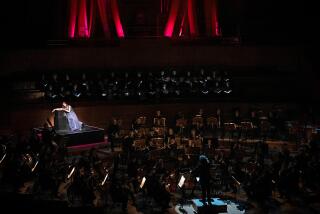Master Chorale Demonstrates the Intense Power of Its Passion
- Share via
The inner life of a legato phrase is probably not of intense interest to most people. Paul Salamunovich and the Los Angeles Master Chorale are not most people, however, and they demonstrated emphatically the power that comes from such interests in a program of sustained lyricism Sunday at the Dorothy Chandler Pavilion.
This was pure choral singing, 60 voices disposed in two choirs unencumbered by instrumental literalism. Salamunovich began with the second choir offstage for the veiled antiphonal responses of Orlando di Lasso’s “Echo Song” and Britten’s “Hymn to the Virgin” and Jan Sandstrom’s striking setting of “Lo, How a Rose E’er Blooming,” with its hummed halo.
The substantial and seldom essayed mysteries of Frank Martin’s 1922 Mass formed the core of the program. Here was singing of enormous strength and control, as Salamunovich spun out the Swiss composer’s long, intertwined lines for maximum tension, letting each blossom at the peak moment in perfect dynamic balance.
A glowing account of Franz Biebl’s popular “Ave Maria” reminded us that one key to Salamunovich’s command of linear momentum comes from his long expertise in Gregorian chant. The second half also held a Palestrina “Stabat Mater” sung with expressive poise and the sonorous “Canticle of Invocation” by local composer James Fritschel.
The weight of 60 voices, even as flexible as these are, left secular part-songs by Giovanni Gabrieli and Adriano Banchieri blandly astylistic. Randall Thompson’s ostentatiously hearty “Ye Shall Have a Song” and a new Gloria--innocuous pop bounce surrounding an edgier center--by Swiss composer Carl Rutti completed the program.
More to Read
The biggest entertainment stories
Get our big stories about Hollywood, film, television, music, arts, culture and more right in your inbox as soon as they publish.
You may occasionally receive promotional content from the Los Angeles Times.










